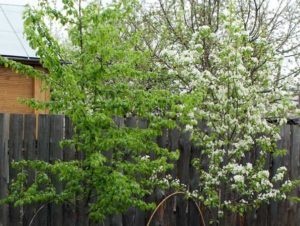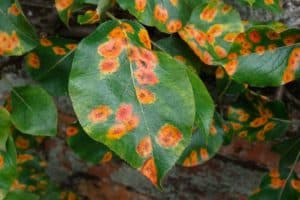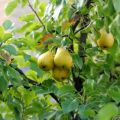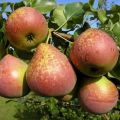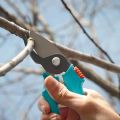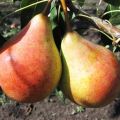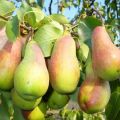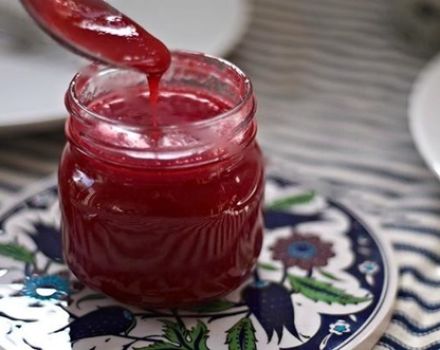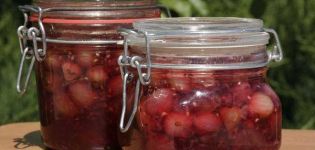Description of diseases and pests of pear, ways to combat them and proper treatment
To grow fruit trees, you need to have the knowledge and skills to care for them. Many of them are damaged by fungal infections that parasitize insects. One must be able to prevent such conditions, to protect the tree from them. Fruit yields will be stable, and there will be no problems with the growing season of the culture if you know everything about pear diseases and pests.
Content
Diseases of pears
Most often, diseases of the fruit crop occur due to improper care of the pear tree. It is necessary to carry out weeding of the garden, loosening the soil in time. After harvesting, trimming, all plant debris is burned.
For the development of pear diseases, certain climatic conditions are also needed. So, some fungal infections develop more often in the Moscow region, where there is a lot of humidity in the air.
Fetal diseases
There are signs of some diseases on the fruits of the pear tree. Then you can be left without a crop, if the pathogenic fungus is not neutralized in time.
Scab
One of the most dangerous pear diseases is associated with the appearance of olive-colored spots on the leaves. And then they move on to fruits. The description of the infection includes the fact that the flesh of the pear begins to harden and crack. If the fungus acts on the pear at the beginning of fruit setting, then their shape is bent.
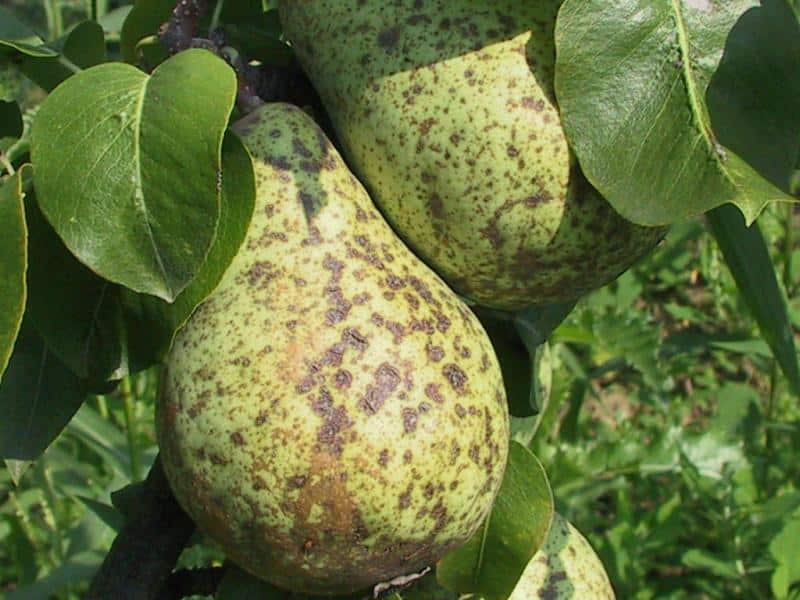
Prevent the development of pathology by spraying with a 3% solution of Bordeaux liquid in spring and 1% after flowering. Trimming the crown will help to improve ventilation and its illumination. In the treatment use drugs "Skor", "Nitrofen".
Fruit rot or moniliosis
When pears are damaged by the moth, spores of the pathogenic fungus are introduced into them. From infected fruits, the disease spreads to neighboring ones. You can identify moniliosis by brown skin, concentric circles of grayish rot on the surface... If the damaged fruits are not removed, then the next year you can be left without a crop. Pears are treated with a solution of Bordeaux liquid before and after flowering. Remember to collect and destroy rotten fruits.
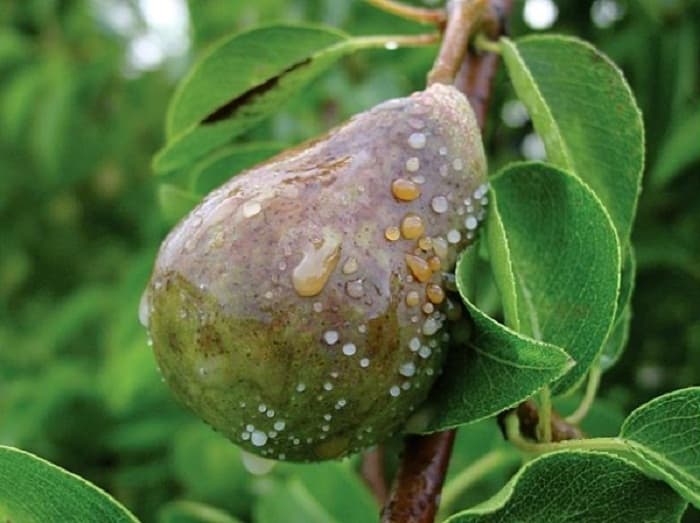
Sooty fungus
When leaves and fruits of pear turn black, then the plant is affected by a sooty fungus. Crops that are weakened or damaged by aphids are affected by the infection.By releasing a sweet and sticky substance, aphids create the soil for the development of a sooty fungus. It is possible to suppress the reproduction of spores of a pathogenic organism by spraying with "Fitosporin".
The prevention of the spread of infection will be the fight against harmful insects, especially aphids.
What leaves sick
Damage to pear leaves occurs on fruit trees more often than on other parts of plants. And already from the leaves, the disease spreads further, destroying the fruits, damaging the stems, shoots.
Powdery mildew
Plants affected by the marsupial fungus are easily recognizable by the white bloom on the young leaves of the pear tree. Over time, instead of it, brown spots appear, which contribute to the drying of the leaves, their falling off.
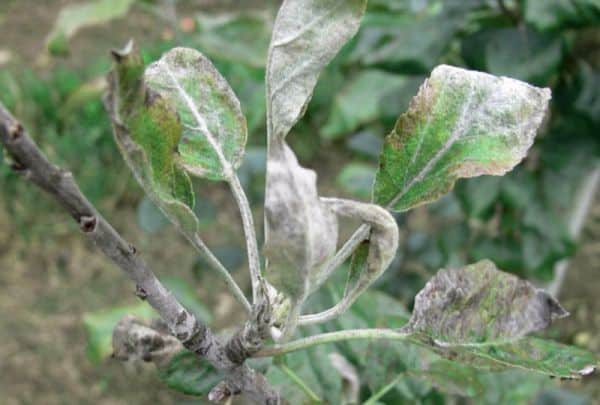
Having found signs of powdery mildew, you need to collect dried leaves and burn, and treat the tree with "Fundazol" three times with a break of 10 days. A solution of soda ash with laundry soap is also effective.
Rust
Pathogenic fungi that cause the disease hibernate on a juniper and then move to a pear. Colonies of parasites over the summer can destroy the fruit crop. A sign of a rust infection is the presence of brown spots on the leaves, which begin to swell by autumn. Processes with spores appear from them. They move by the wind to the juniper in order to begin their disease-causing activity in the spring.
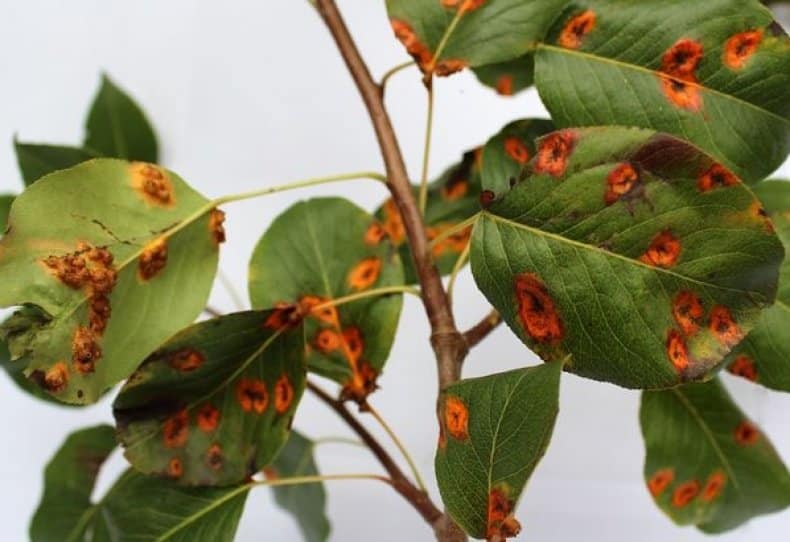
Noticing rusty spots in spring on the foliage of a pear, it is urgent to remove all diseased leaves, cut off the branches. For processing, either a solution of Bordeaux liquid or copper oxychloride is suitable. An infusion of wood ash is also suitable, 500 grams per bucket of water. And the juniper must be removed from the garden or transplanted to another place, away from the pear tree.
Brown spot or phyllostictosis
In May-June, the disease manifests itself as light green spots on the leaves. They are round and small in size. Then the color of the spots changes to yellow or brown. Below, on the leaf plates of the pear, a grayish or brown bloom is visible, in which there are spores. The leaves begin to die off, which leads to a lag in the growth of the pear. In the fight against phyllostictosis, it is necessary to use drugs against the fungus. A solution of Bordeaux mixture 1% is effective, as well as copper sulfate.

Mosaic disease
Leaves with whitish rings on the plate are a sign of a viral disease. The danger of the disease is that it is impossible to cure the plant. It is better to uproot diseased trees to save the garden from destruction. The fight against the virus is to destroy parasitic insects of fruit crops in time.
Septoriasis
One of the common pear diseases, septoria, is characterized by white dots on the leaf blade. The contour of the spot is outlined with a dark brown border. In the center of them are the spores of the fungus, which multiply in the warm, humid summer. If you do not fight the pathology, then by August the foliage from the pear will fall off, and the tree will enter the winter weakened.
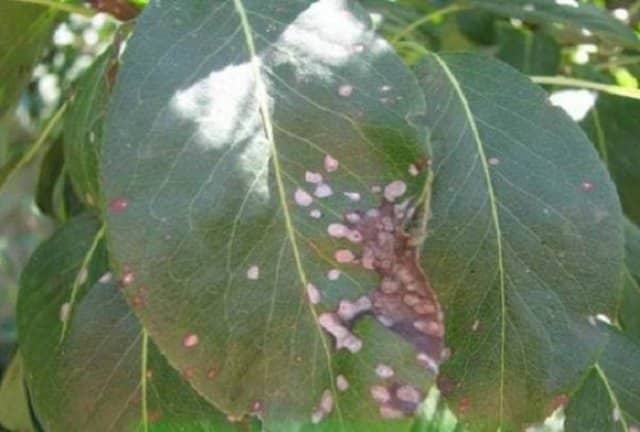
Infection can be prevented by cleaning and burning the foliage in the fall, digging the trunk circle. Of the preparations, fungicides are used, spraying the garden in 3 stages.
Stem and root diseases of pear
There are diseases that affect the stems, shoots of the fruit tree. Most often these are viral infections that are especially dangerous for the life of the culture. They lead to deformation of the trunk, the appearance of growths, cones, and depressions on the bark.
Black pear cancer
How Antonov fire burns a tree disease. The trunk and branches look burnt. The bark bursts, becomes covered with cracks, the edges of which are constantly wet. They are penetrated by pathogenic microorganisms, fungal spores.
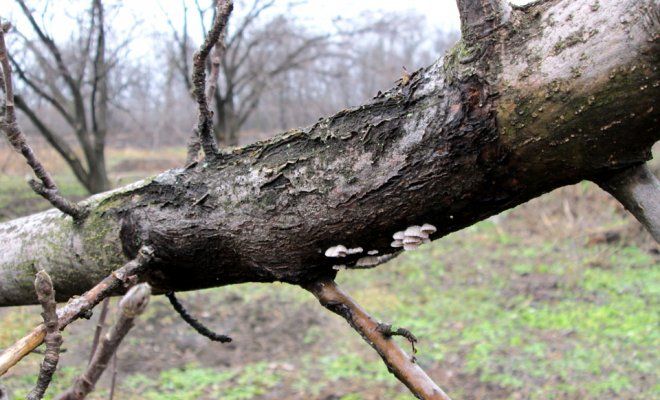
Treatment for pear cancer is to cut the bark into healthy tissue. At the same time, the sections are treated with a solution of copper sulfate, covered with garden var. In the initial stages of the disease, you can save the pear.
Cytosporosis
The fungus of cytosporosis affects the bark of horticultural crops.Most often, it penetrates into the tissues of a tree in places of burns, frost damage. On the affected area, it begins to flake off, dry out, and become a red-brown bark.To combat the disease, the damaged bark is cleaned by coating the cut sites with clay or pitch. It is necessary to protect the pears from damage by whitening the trunks in the fall and spring.
Root cancer
The disease manifests itself on the roots, more often the root collar. Its signs include growths of various sizes and shapes. Small, gray-white, pea-like tumors. But, developing, they increase in size, turn brown, lignify.
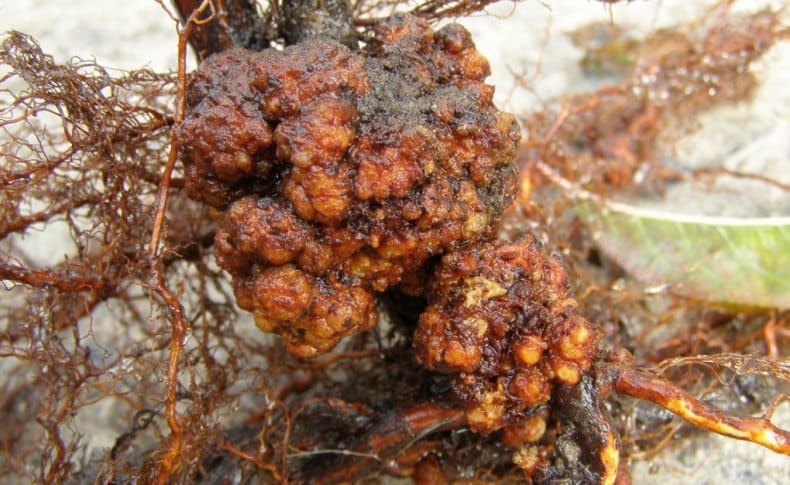
Saplings affected by cancer die, although at first they develop rapidly. Before planting pear seedlings, you must carefully examine the root system, removing growths. After trimming, it is necessary to process the roots with a solution of copper sulfate, and then rinse with water. A solution of boric acid, 10 grams per 10 liters of water, is suitable as a disinfectant.
Bacterial burn
Symptoms of a fire blight include:
- blackening of the kidneys, their drying out;
- drying of inflorescences;
- curling leaves;
- darkening of the trunk.
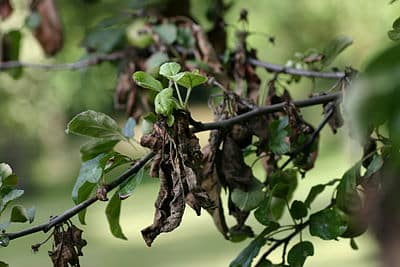
It is difficult to detect the disease right away. When a tree is completely black, it cannot be saved. With a small infection, diseased branches can be cut off and burned. The cut point must be treated with copper sulfate.
To get rid of a bacterial burn is advised with copper-containing preparations such as "Skor".
Pear parasites and methods of dealing with them
Fruit crops have many pests trying to live off them. Pears suffer from both large parasites, butterfly larvae, and from completely invisible, but causing great harm to fruits, leaves, flowers and tree shoots.
Gall mite
The length of an adult reaches a little less than 2 millimeters, so it is difficult to notice an insect with a white or pinkish body color.

Pests overwinter in kidney scales, where the female lays eggs. From them hordes of hungry ticks appear, which dig into the blossoming leaves. Swellings, galls appear on the leaf plates. Sticking together, they form a continuous tumor. After some time, the galls begin to crack, then the mites are looking for new places to feed themselves. Insects negatively affect the development of the tree, fruits, therefore, the fight against them must be timely.
Treatment of the plant with organophosphorus preparations and containing chlorine will be effective. It is necessary to spray the pear twice with a break of 2 months.
Hawthorn butterfly
A large butterfly with white wings laced with black veins can often be seen in the garden. Its larvae are dangerous for the pear tree. Caterpillars of gray color with longitudinal orange stripes are gluttonous, destroying ovaries, leaves, and flowers of the plant.

You can fight parasites by destroying their nests, which they prepare from leaves rolled into a tube, wrapping them with cobwebs. It is necessary to treat the tree and the ground around in a timely manner with insecticides such as "Chlorophos".
Sawfly
Sawflies, which are especially common in wet periods, pose a hazard to the crop. The female lays eggs in the receptacle of each bud. Then larvae develop in them, which do not go outside, but feed, making moves in the fruits of the pear. During a development period of 20 days, 1 larva will destroy up to 4 fruits. The vital activity of the sawfly leads to a loss of 60% of the crop.
The number of insects decreases where regular digging of the root circle is carried out, the soil is loosened. It is necessary to spray the tree before flowering and after with products containing organophosphorus compounds.
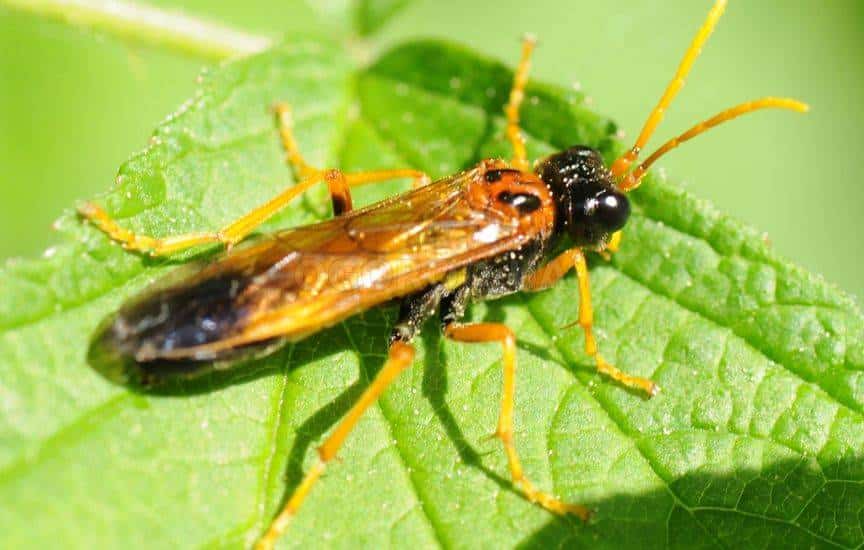
Pear Copper
Of all types of sucker, the spotted one does the most damage to the tree. During the season, 3-4 generations of the parasite develop. It is necessary to start fighting insects in early spring, until the leaves bloom. You can cure a pear by spraying with drugs on a warm, windless, always sunny day. It is then that the coppers are active.The tree is treated with "Aktara" or "Karate". Before and after flowering it is better to spray the plant with "Dimilin". You also need to carry out procedures in July 2 times with an interval of 10 days.
Pear moth
The butterfly is an insect with dark gray wings, decorated with transverse striation. In July, butterflies stop flying, at this time the caterpillars, having hatched from the eggs, begin to actively feed on the pulp of the pear. Up to 5 larvae can settle in one fruit. After feeding, caterpillars leave the fruits and go to winter in cocoons under the roots of weeds.
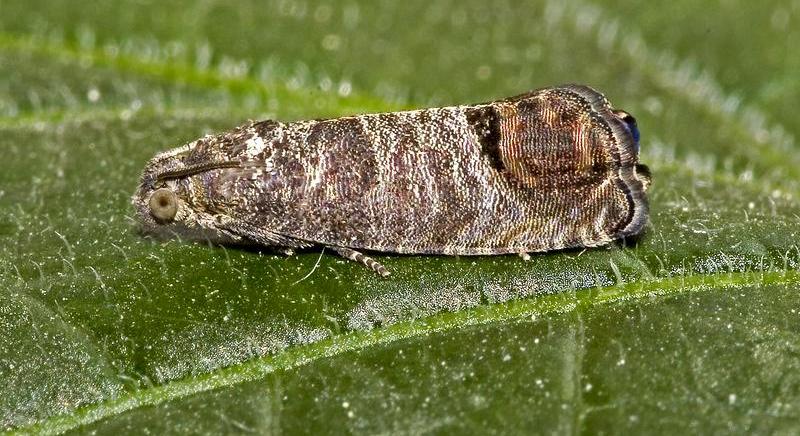
It is necessary to clean the garden from foliage, dig up the ground around the trees, then the frost will destroy the larvae of the parasite.
Sapwood
The beetle damages the bark of the fruit crop by making horizontal passages inside. The gum starts flowing at the tree, and it weakens. White larvae gnaw through the transverse passages, which leads to severe damage to the pear and even its death. Sapwood control includes:
- pruning and burning diseased branches;
- cleaning the bark from lichens and mosses;
- whitewashing the trunk;
- spraying with "Aktara" after flowering with repetition of treatment after 2 weeks.

Injections into the bark of solutions "Arrivo", "Decis" help.
Aphid gray
Aphids invisible to the eye do great harm to the garden. Having settled on the leaves of a pear, it leaves its sticky secretions. Because of this, a young seedling is affected by a sooty fungus. Although it is difficult to spot aphids, it can be identified by the ants on the pear.
Also, the leaves begin to curl at the ends, become sticky to the touch. By turning the bottom of the plate, you can see the colonies of the parasite.
Treatment against aphids is carried out with chemicals three times. The most effective drugs are "Confidor", "Fitoverm". From folk remedies, spraying with soapy water, infusion of flowers and dandelion stalks is used in the summer.
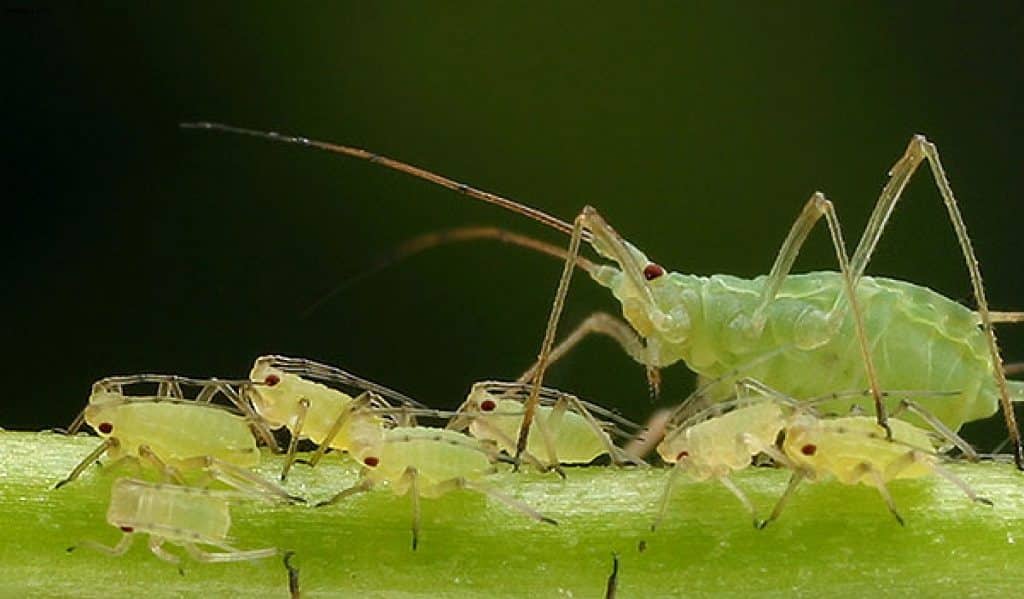
Leaf roll
The insect is 2.5 mm in size and has a dark green or yellowish color with a waxy coating. Its fertility is striking, because the female lays up to 500 eggs per season. Like leaf-eating parasites, pests settle on the green parts of the plant, starting to feed on them. Aphids are determined by leaves twisted into a tube, by a sticky substance flowing down the bark and branches.
The fight against insects is started in early spring by spraying the plants with "Preparation 30". Later, the means "Landing", "Atom" are used. Getting rid of the leaf rollers will bring bait. Fermented juice or compote is poured into tin cans and hung on the trees overnight. In the morning they will be filled with adult insects. You can manually collect the leaves with a straw where the leaf rollers are located, and burn them.
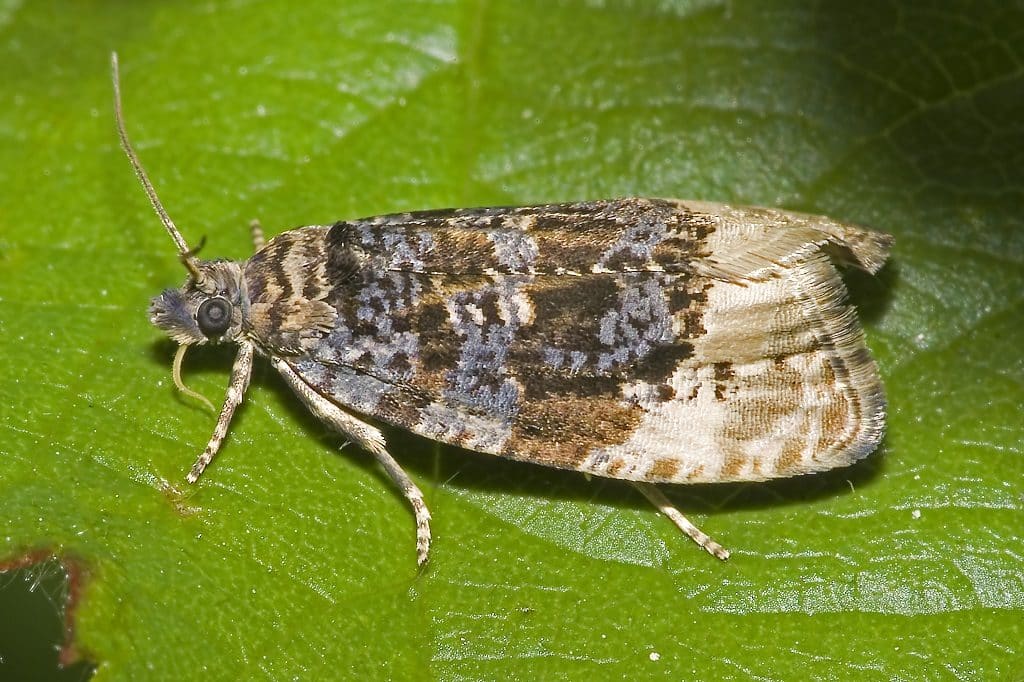
Prevention and protection of pear trees from diseases and pests
Preventing disease and pest attacks on horticultural crops is easier than treating them later. After all, you will have to use chemicals, which bears some harm to the pear fruits. Preventive measures must be carried out on time:
- A place for planting pears is chosen where the soil does not become swamped due to the close location of groundwater.
- They dig up the trunk circle in the fall, after harvesting and in the spring.
- Loosening and weeding are important in disease prevention and pest control.
- Pruning dry, damaged twigs will provide an opportunity to increase lighting and fresh air flow into the crown.
- The burning of plant residues is carried out without fail, thereby destroying hibernating pests and pathogenic microorganisms.
- They take care of the bark, patching up cracks, damage with pitch, whitening.
- The garden is sprayed with Bordeaux liquid in spring and autumn.

These are the main measures to prevent disease. But we must apply our own treatment for each type of pathology.
Fight against diseases and pests with folk remedies
Chemicals, insecticides, acaricides, pesticides, fungicides are used when it is impossible to cope with neglected pathology. In the initial stages, folk remedies, tested by gardeners in practice, are suitable. Pears affected by aphids and mites are treated with tobacco infusion. It is prepared from a kilogram of tobacco waste per 5 liters of water. After 24-hour infusion, place the container on the fire, boil for an hour. As soon as the solution has settled, it is filtered and diluted with water. 500 milliliters of infusion is poured into a bucket of water.
For better adhesion to the leaves, add 100 grams of laundry soap shavings.
The infusion of onion husks is prepared as follows: 20 grams of husks are insisted in 1 liter of water. Spray trees affected by aphids, mites, 3 times a month with a break of 10 days.The sawfly is afraid of sulfur fumigation. Half of the matchbox is put into the smoker, blowing smoke on the pears.
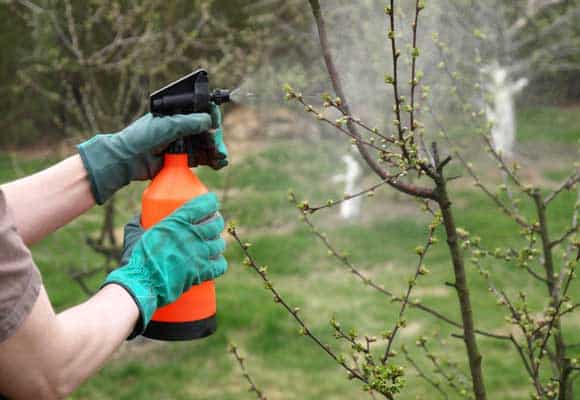
Infusion of soda and soap helps with powdery mildew. It is processed after the leaves bloom every 7 days. You can not carry out the procedure during flowering. You can replace the agent with an infusion of manure, which is prepared from 1 part of a mullein and 3-4 parts of water. Before processing, the solution is diluted with water 1: 3. Used for spraying against pests infusion of red pepper, dandelion, chamomile, celandine.
Is it possible to spray a pear with fruits
There are certain rules and terms for processing pears from pests and diseases. Usually, the procedure is carried out in early spring before the leaves bloom. Then, the period before the appearance of flowers and after they fall will be favorable. Do not use chemicals during pear fruiting. This will negatively affect the harvest. In rare cases, you can use folk remedies, but 2 weeks before harvesting the fruits.
